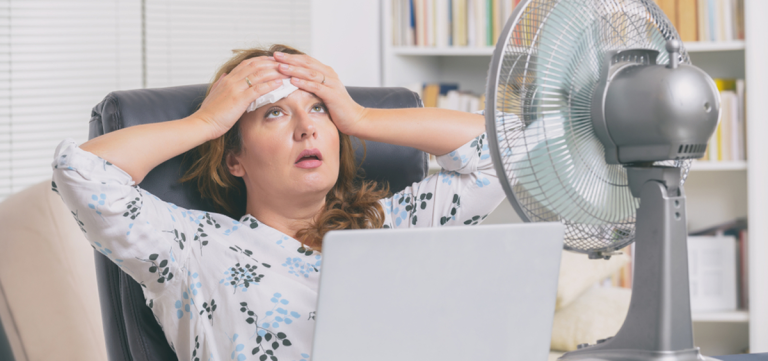Excessive Sweating (Hyperhidrosis) Causes, Symptoms, and Treatment Methods
Excessive sweating, also known as hyperhidrosis, which is a condition of overactive sweat glands, occurs when excessive amounts of chemical stimuli secreted from the brain for various reasons reach the sweat glands. Although sweating alone is a physiological event necessary for the body’s temperature control, excessive sweating may occur in the form of drops on the hands, feet, armpits, or head for no apparent reason. This may be accompanied by a flushed face, or facial flushing may occur alone without sweating.
What Causes Excessive Sweating?
Excessive sweating is divided into primary (regional) and secondary. Primary, i.e. regional sweating, can occur in a healthy individual without any underlying disease. In some cases; excessive stress, anxiety or excessively spicy and bitter foods can trigger sweating.
Secondary hyperhidrosis is usually the result of other diseases. The main ones are as follows:
- Cancer
- Diabetes
- Thyroid disease
- Heart failure
- Adrenal gland diseases
- Lung disease
- Parkinson’s
- Obesity
- Menopause
- Psychological disorders
What are the Symptoms of Excessive Sweating?
- The symptoms of excessive sweating vary according to their severity and their impact on daily life. Minor symptoms may appear and disappear periodically. However, if excessive sweating is at advanced levels, this condition can reach disturbing dimensions during the day.
- We can list the effects of excessive sweating on daily life as follows:
- Your armpits or back may become waterlogged due to excessive sweating.
- Your clothes may get wet from sweat and you may need to change them.
- Beads of sweat may drip from your cheeks or forehead.
- On the other hand, excessive sweating can also cause some disorders in the body.
- Itching or inflammation may occur as a result of prolonged abrasion of the sweating area.
- Although sweating alone does not cause odor, sweat drops can cause odor formation when combined with bacteria on the body.
- Cracks, wrinkles or skin discoloration may occur.
- The skin layer on the soles of the feet may break down or become unusually soft.
Which Parts of the Body are Most Affected by Excessive Sweating?
In case of excessive sweating, although every part of the body is usually affected, symptoms may become more frequent in some parts. These are
- Underarm
- The soles of the feet
- Facial area (especially cheek and forehead)
- Back
- Genital area
- Palms on hands
- Neck
In which cases should a doctor be consulted?
Excessive sweating can also be a symptom of other underlying diseases. For this reason, if you are experiencing the following conditions, it is recommended that you consult an internal medicine or chest disease specialist.
- Weight loss associated with excessive sweating
- Excessive sweating, especially while sleeping
- Fever, chest pain, difficulty breathing, or heart palpitations accompanied by excessive sweating
- Prolonged and unexplained excessive sweating
How is Excessive Sweating Diagnosed?
The diagnosis of the disease is made by physical examination and listening to the patient’s complaints. A patient who applies to the hospital with the complaint of excessive sweating is first examined by endocrinology, psychiatry, and dermatology specialists and it is investigated whether there is another underlying disease with methods such as blood tests. If no results are obtained from the treatments recommended in these departments, treatment options suitable for primary sweating are offered to the patient.
What are the Treatment Methods for Excessive Sweating?
If the patient has secondary sweating, the underlying disease should be treated. However, in cases where sweating is primary, i.e. localized, treatment options are as follows:
Treatment with antiperspirant
Patients diagnosed with excessive sweating are first applied special antiperspirants. Antiperspirants aim to prevent sweating by closing the outlet of the sweat glands. This method can be effective for patients with mild to severe sweating and offers short-term solutions such as a few hours.
Surgical Treatment (ETS Surgery)
The most definitive solution for excessive sweating is Endoscopic Thoracic Sympathectomy or ETS surgery. ETS surgery; It is preferred in the treatment of excessive sweating cases that occur especially in the armpit, hand, foot, and face area and excessive redness problems on the face.
The operation is performed under general anesthesia. During the operation, two small incisions are made under the armpit. A small tube-shaped device called an endoscope is inserted into one of the incisions and the problematic nerves causing sweating are detected by means of the light camera at the end. With the help of another tool, a clip is inserted into the other incision and these nerves are blocked. Thus, it is aimed to eliminate the sweating problem.
As a possible side effect, in some cases, sweating may occur in another part of the body. Although this condition usually disappears over time, a second surgical intervention can be performed on the cut nerve if it does not disappear.
The success rate in the treatment of sweating with ETS surgery is around 90 percent, depending on the area treated. According to a study, 60 percent of patients who undergo ETS surgery do not complain of sweating even after 12 years.


